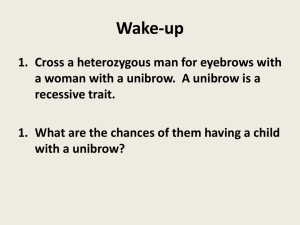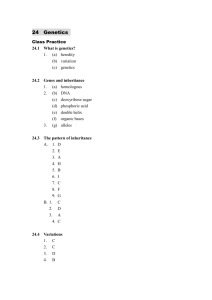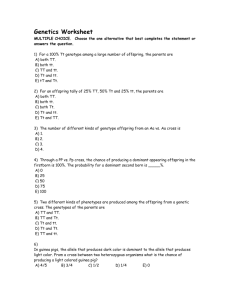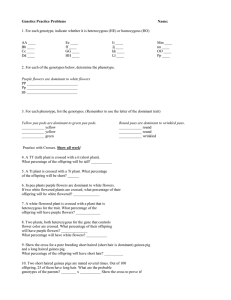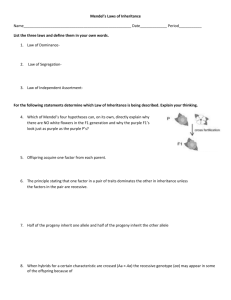Genetics_Review_for_2011
advertisement
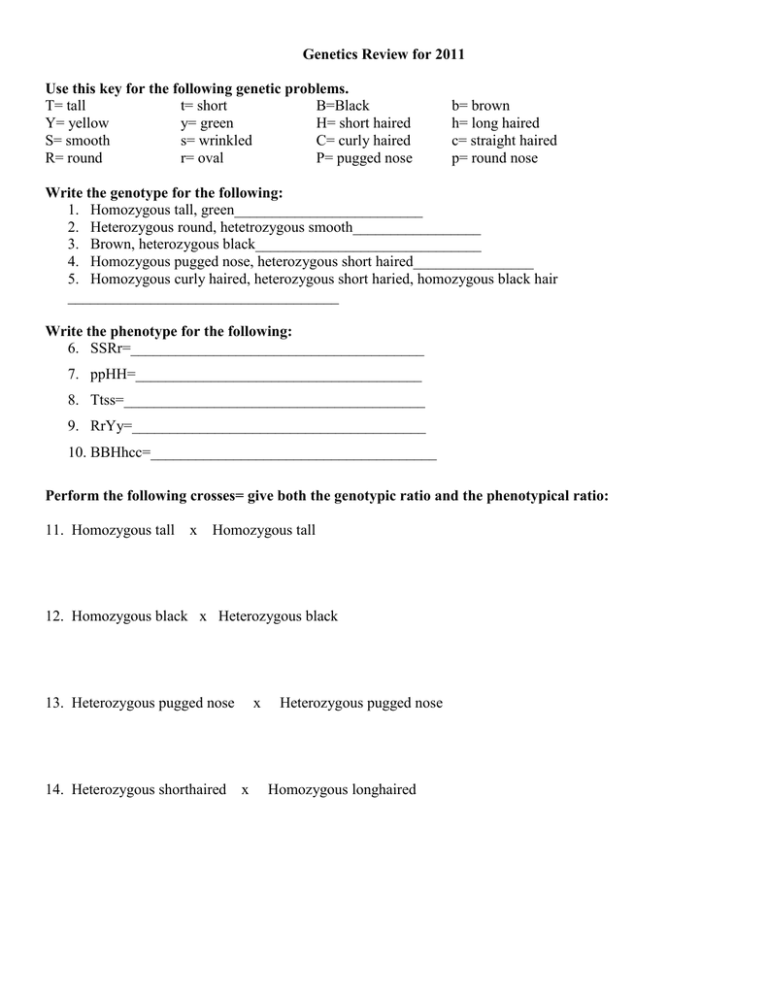
Genetics Review for 2011 Use this key for the following genetic problems. T= tall t= short B=Black Y= yellow y= green H= short haired S= smooth s= wrinkled C= curly haired R= round r= oval P= pugged nose b= brown h= long haired c= straight haired p= round nose Write the genotype for the following: 1. Homozygous tall, green_________________________ 2. Heterozygous round, hetetrozygous smooth_________________ 3. Brown, heterozygous black______________________________ 4. Homozygous pugged nose, heterozygous short haired________________ 5. Homozygous curly haired, heterozygous short haried, homozygous black hair ____________________________________ Write the phenotype for the following: 6. SSRr=_______________________________________ 7. ppHH=______________________________________ 8. Ttss=________________________________________ 9. RrYy=_______________________________________ 10. BBHhcc=______________________________________ Perform the following crosses= give both the genotypic ratio and the phenotypical ratio: 11. Homozygous tall x Homozygous tall 12. Homozygous black x Heterozygous black 13. Heterozygous pugged nose 14. Heterozygous shorthaired x x Heterozygous pugged nose Homozygous longhaired GENETICS PRACTICE 1: BASIC MENDELIAN GENETICS Solve these genetics problems. Be sure to complete the Punnett square to show how you got your solution. 1. In humans the allele for albinism is recessive to the allele for normal skin pigmentation. If two heterozygotes have children, what is the chance that a child will have normal skin pigment? What is the chance that a child will be albino? Genotype for normal pigment: Genotype for albino: a. If the child is normal, what is the chance that it is a carrier (heterozygous) for the albino allele? (CAREFUL!) 2. In purple people eaters, one-horn is dominant and no horns is recessive. Show the cross of a purple people eater that is heterozygous for horns with a purple people eater that does not have horns. Summarize the genotypes & phenotypes of the possible offspring? GENETICS PRACTICE 2: PROBABILITY PRACTICE 1. In humans, curly hair is dominant over straight hair. A woman heterozygous for hair curl marries a man with straight hair and they have children. a. What is the genotype of the mother? _________________________________________ b. What gametes can she produce?_____________________________________________ c. What is the genotype of the father? __________________________________________ d. What gametes can he produce?______________________________________________ e. What is the probability that the 1st child will have curly hair?_______________________ f. What is the probability that the 2nd child will have curly hair?_______________________ 2. List all the gametes that are possible with each of the following genotypes. a. Aabb ___________________________ d. AABb _____________________________ b. AaBB ___________________________ e. AAbb _____________________________ c. AaBb ___________________________ f. aabb _____________________________ 3. What is the probability of getting the gamete (ab) from each of the following parents? a. Aabb __________________________________________________________________ b. aaBb __________________________________________________________________ c. AaBb __________________________________________________________________ d. AABb __________________________________________________________________ e. AAbb __________________________________________________________________ GENETICS PRACTICE 3: Multiple alleles You are a scientist performing the first analysis of the genetic basis for the inheritance of flower color in a certain species of wildflower. You begin your investigation by observing that there are four different flower colors in the local wild population: white, red, blue and purple. Your first assumption (hypothesis) is that you are looking at the effects of a single gene, so operate under that assumption. You collect a variety of samples of all colors, take them back to your greenhouse, and begin making crosses. Remember, you are crossing members of a wild population—you have no idea whether any of your plants are homozygous or heterozygous. Here are the various results you observe: White X White Red X Red Blue X Blue Purple X Purple White X Red White X Blue White X Purple Red X Blue a. b. c. All offspring always produce white flowers. In some matings, all offspring produce red flowers. In other matings, some of the offspring produce red flowers, some white, with red flowering offspring outnumbering white flowering offspring. In some matings, all offspring produce blue flowers.. In other matings, some of the offspring produce blue flowers, some white with blue flowering offspring outnumbering white flowering offspring. Always produces a mixture of red, blue and purple flowering offspring, with purple most frequent, followed by red and blue in roughly equal numbers, In some matings, all offspring produce red flowers. In other matings, some of the offspring produce red flowers, some white. Red and white occur in roughly equal numbers.. In some matings, all offspring produce blue flowers. In other matings, some of the offspring produce blue flowers, some white. Blue and white occur in roughly equal numbers.. Always produces roughly equal numbers of blue flowering offspring and red flowering offspring. Always produces purple offspring, but in some matings also produces red and/or blue offspring, and/or white offspring Red X Purple Always produces red and purple offspring, sometimes mixed with blue. Blue X Purple Always produces blue and purple offspring, sometimes mixed with red. How many alleles are governing flower color in this plant? What color does each of these alleles produce (in other words, what colors are your homozygous plants)? Explain the dominance relationships among your alleles, and explain the results of each of the crosses described above. 7. A woman has a daughter. There are three men whom she claims might have been the father of the child. The judge in the paternity court orders that all three men, the child, and the mother have blood tests. The results are: mother, Type A; Daughter, Type O; Man #1, Type AB; Man #2, Type B; Man #3, Type O. The mother claims that this proves that Man #3 must be the little girl’s father. a. Is the mother correct? Why or why not? b. The judge isn’t satisfied, so he asks for the medical records of the people involved. He discovers that the little girl is colorblind. Men #’s 1 and 2 are also colorblind; Man #3 has normal color vision, as does the mother. (NOTE: Colorblindness is X-linked and recessive.) Assuming that one of these three men must be the father, can you now determine which of the three it is? Problems Involving Gene Interactions 1. In cats, there is a gene which produces ticked fur (bands of different colors on each hair) called Agouti (H). The recessive allele (h) for this gene produces hair which is a solid color from end to end. In addition, there is a coat color gene which has a recessive albino allele (a) which, in the homozygote, prevents the production of any coat color pigment, resulting in a white cat with pink eyes, the traditional albino. Note that this problem has described two completely different genes. These genes are unlinked. An albino female cat is mated to a solid brown male cat. All of their offspring are Agouti. The males and females among these offspring are allowed to freely intermate, producing a flock of F2 kittens. Predict the phenotypic ratio for fur color among these many grandkittens.
